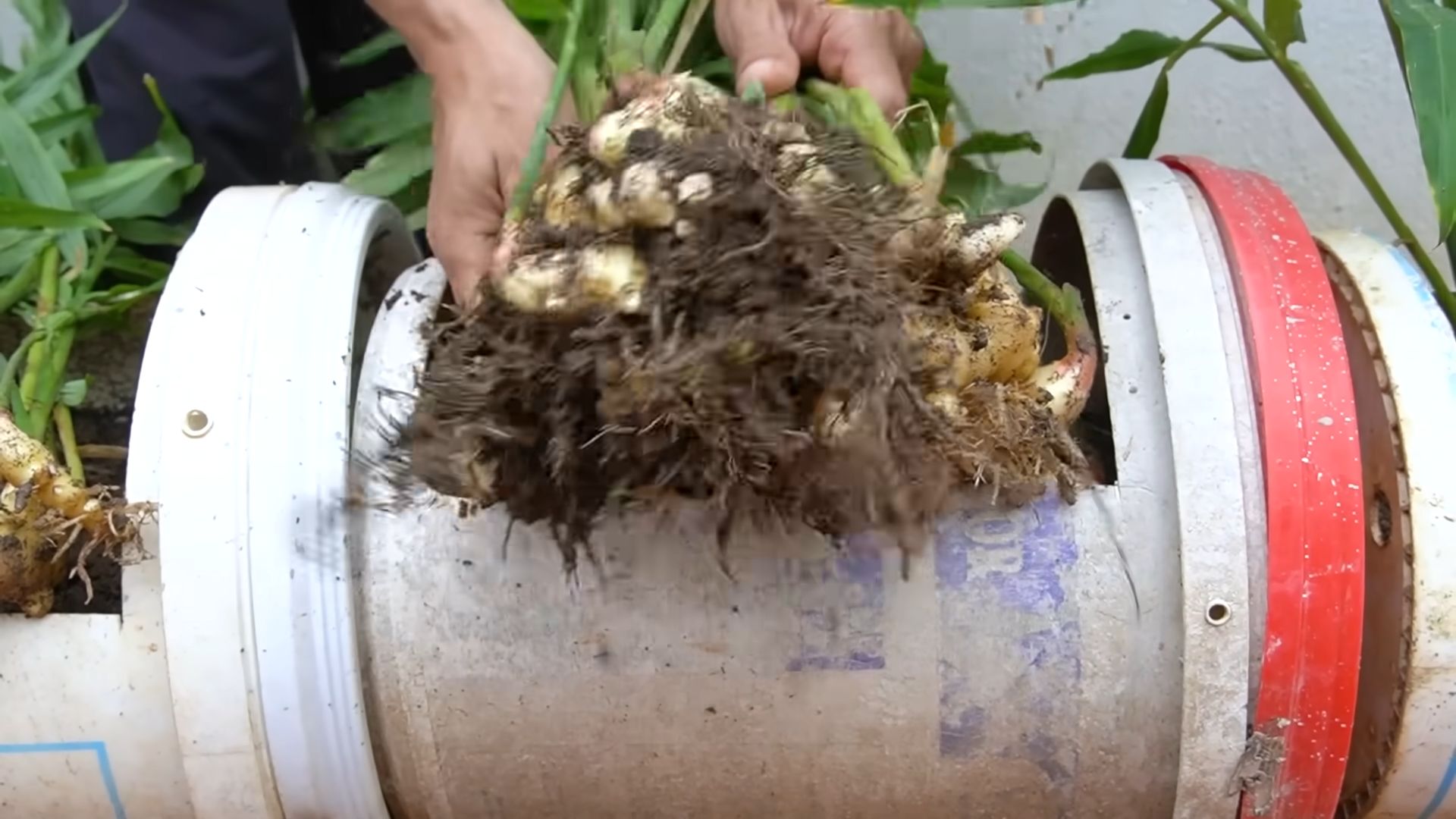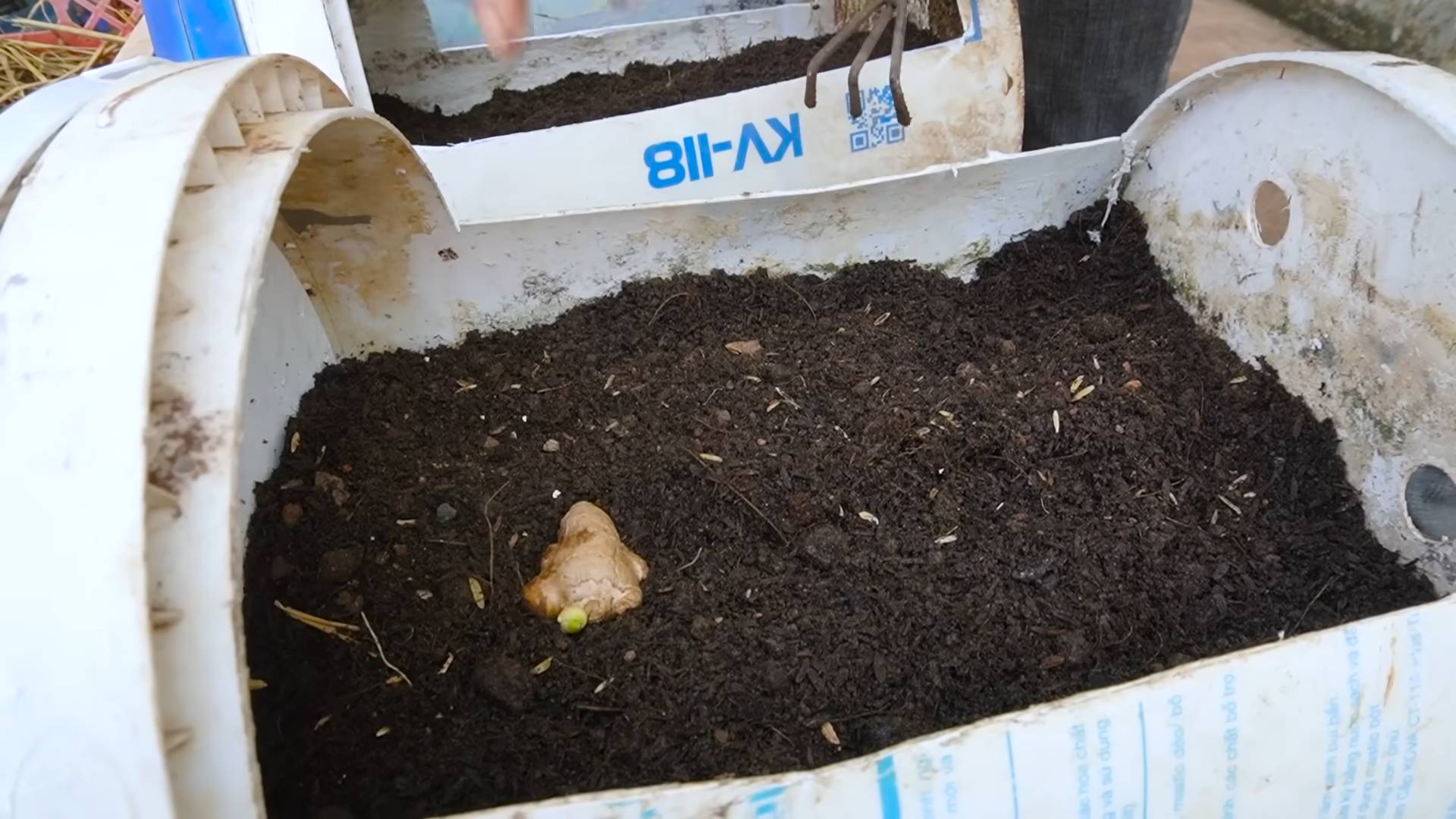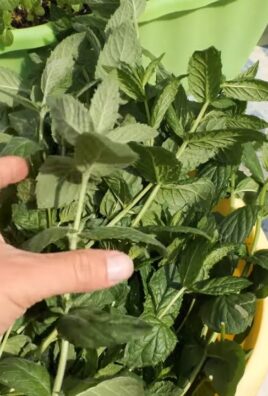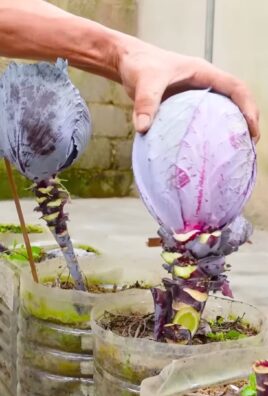Planting Ginger at Home might seem intimidating, but trust me, it’s easier than you think! Have you ever wondered how amazing it would be to have a constant supply of fresh, zesty ginger right at your fingertips? Imagine adding a freshly harvested piece to your morning smoothie or using it to spice up your favorite stir-fry. That’s the magic of home gardening!
Ginger, with its rich history rooted in ancient Asia, has been prized for centuries, not just for its culinary uses but also for its incredible medicinal properties. From traditional remedies to modern cuisine, ginger has truly stood the test of time. But beyond its historical significance, growing your own ginger is incredibly rewarding.
In today’s world, where we’re all looking for ways to be more sustainable and connected to nature, planting ginger at home offers a fantastic opportunity to do just that. Plus, store-bought ginger can sometimes lack the vibrant flavor of freshly grown rhizomes. This DIY guide will walk you through every step, from selecting the perfect ginger root to harvesting your very own supply. So, get ready to roll up your sleeves and discover the joy of growing your own ginger – you’ll be amazed at how simple and satisfying it is!

Growing Ginger at Home: A Beginner’s Guide
Hey there, fellow plant enthusiasts! Ever thought about growing your own ginger? It’s surprisingly easy and incredibly rewarding. Imagine having fresh, organic ginger right at your fingertips whenever you need it for cooking, tea, or even just a little health boost. I’m going to walk you through the whole process, step-by-step, so you can enjoy the satisfaction of harvesting your own homegrown ginger. Let’s get started!
Choosing Your Ginger Rhizome
Before we dive into the planting process, let’s talk about selecting the right ginger. This is crucial for a successful harvest.
* Look for plump, healthy rhizomes: When you’re at the grocery store or nursery, choose ginger rhizomes (the “root” part we eat) that are firm, plump, and free from wrinkles or blemishes. Avoid any that look shriveled or moldy.
* Eyes are key: The rhizome should have visible “eyes” or buds, which are small, green points where new shoots will emerge. The more eyes, the better!
* Organic is best: If possible, opt for organic ginger. Non-organic ginger may have been treated with growth inhibitors, which can hinder sprouting.
* Soaking for Success: If you’re unsure about the ginger’s history, soak it in water overnight before planting. This can help remove any potential growth inhibitors.
Preparing Your Planting Container and Soil
Now that you have your ginger rhizome, it’s time to get your planting setup ready.
* Container Size Matters: Ginger needs room to spread its roots, so choose a wide, shallow container. A pot that’s at least 12 inches wide and 6-8 inches deep is ideal. Remember, drainage is key! Make sure your container has drainage holes to prevent waterlogging.
* Soil Selection: Ginger thrives in well-draining, nutrient-rich soil. A good potting mix is essential. I like to use a mix of:
* Potting soil (50%)
* Compost (25%) – This adds nutrients and improves drainage.
* Perlite or Vermiculite (25%) – This helps with aeration and drainage.
* Why Drainage is Important: Ginger rhizomes are susceptible to rot if they sit in soggy soil. The well-draining soil mix and drainage holes in your container will help prevent this.
Planting Your Ginger Rhizome
Alright, let’s get our hands dirty! This is where the magic happens.
1. Fill the Container: Fill your chosen container with the prepared soil mix, leaving about an inch or two of space at the top.
2. Position the Rhizome: Place the ginger rhizome horizontally on top of the soil, with the “eyes” facing upwards.
3. Cover Lightly: Cover the rhizome with about 1-2 inches of soil. Don’t bury it too deep, as this can hinder sprouting.
4. Water Gently: Water the soil gently until it’s evenly moist but not waterlogged.
5. Location, Location, Location: Place the container in a warm, humid location with indirect sunlight. Ginger loves warmth and humidity, but direct sunlight can scorch the leaves. An east-facing window or a spot under a shade cloth is perfect.
Caring for Your Ginger Plant
Once your ginger is planted, it’s time to provide it with the care it needs to thrive.
* Watering: Keep the soil consistently moist, but not soggy. Water when the top inch of soil feels dry to the touch. Overwatering can lead to root rot, so be careful!
* Humidity: Ginger loves humidity. If you live in a dry climate, you can increase humidity by:
* Misting the plant regularly with water.
* Placing the pot on a tray filled with pebbles and water (make sure the bottom of the pot isn’t sitting directly in the water).
* Using a humidifier near the plant.
* Fertilizing: Feed your ginger plant every 2-3 weeks with a balanced liquid fertilizer diluted to half strength. This will provide the nutrients it needs to grow strong and healthy.
* Temperature: Ginger thrives in temperatures between 65°F and 90°F (18°C and 32°C). Protect it from frost and cold drafts.
* Pest Control: Keep an eye out for pests like aphids or spider mites. If you spot any, treat them with insecticidal soap or neem oil.
Harvesting Your Ginger
The most exciting part! Harvesting your homegrown ginger.
* When to Harvest: You can start harvesting ginger about 8-10 months after planting. The leaves will start to turn yellow and die back, indicating that the rhizomes are mature.
* Partial Harvest: If you only need a small amount of ginger, you can carefully dig around the edges of the pot and harvest a piece of the rhizome. Be sure to leave the rest of the plant undisturbed so it can continue to grow.
* Full Harvest: For a full harvest, carefully dig up the entire plant, being careful not to damage the rhizomes.
* Cleaning and Storing: Once you’ve harvested your ginger, wash it thoroughly to remove any dirt. You can store fresh ginger in the refrigerator for several weeks. For longer storage, you can freeze it or pickle it.
Troubleshooting
Even with the best care, you might encounter some challenges along the way. Here are a few common problems and how to address them:
* Yellowing Leaves: This could be a sign of overwatering, underwatering, or nutrient deficiency. Check the soil moisture and adjust your watering accordingly. If the soil is consistently moist, reduce watering. If it’s dry, water more frequently. Also, make sure you’re fertilizing regularly.
* No Sprouting: If your ginger isn’t sprouting, it could be due to several factors:
* The rhizome may not have been viable.
* The soil may be too cold.
* The rhizome may have been planted too deep.
Try starting with a fresh rhizome and ensuring the soil is warm and well-draining.
* Root Rot: This is caused by overwatering and poor drainage. If you suspect root rot, carefully remove the plant from the pot and inspect the roots. If the roots are mushy and brown, trim away the affected areas and repot the plant in fresh, well-draining soil.
Enjoying Your Homegrown Ginger
Now that you’ve successfully grown and harvested your own ginger, it’s time to enjoy the fruits (or rather, rhizomes) of your labor! Here are just a few ways to use your homegrown ginger:
* Cooking: Add fresh ginger to stir-fries, soups, curries, and other dishes for a zesty flavor.
* Tea: Brew a soothing cup of ginger tea by steeping sliced ginger in hot water.
* Smoothies: Add a small piece of ginger to your smoothies for a spicy kick and a boost of nutrients.
* Pickling: Pickle ginger to enjoy as a condiment or snack.
* Candied Ginger: Make candied ginger for a sweet and spicy treat.
Growing ginger at home is a fun and rewarding experience. With a little patience and care, you can enjoy fresh, organic ginger whenever you need it. Happy gardening!

Conclusion
So, there you have it! Planting ginger at home is not only surprisingly simple, but it’s also incredibly rewarding. Imagine the satisfaction of harvesting your own fresh, flavorful ginger root, knowing exactly where it came from and how it was grown. Forget those bland, store-bought rhizomes that have been sitting on shelves for weeks. With this easy DIY trick, you can have a constant supply of vibrant, aromatic ginger right at your fingertips.
But why is this a must-try? Beyond the freshness and flavor, growing your own ginger offers a connection to nature and a sense of accomplishment. It’s a fantastic way to reduce your reliance on grocery stores, minimize your carbon footprint, and add a touch of green to your living space, even if you only have a small balcony or windowsill. Plus, it’s a fun and educational project for the whole family!
Don’t be afraid to experiment with different varieties of ginger. While common ginger (Zingiber officinale) is the most readily available, you might be able to find other types like galangal or turmeric, which can be grown using similar methods. Consider using different types of potting mix to see which works best for your environment. You can also try growing ginger in different containers, from traditional pots to repurposed buckets or even raised garden beds.
For those living in colder climates, remember that ginger is a tropical plant and needs warmth to thrive. You can easily grow it indoors year-round, providing it with plenty of sunlight and warmth. If you’re growing ginger outdoors, be sure to bring it inside before the first frost.
We’re confident that you’ll find planting ginger at home to be a delightful and fulfilling experience. It’s a simple yet powerful way to connect with nature, enhance your culinary creations, and enjoy the unparalleled flavor of homegrown ginger.
Now it’s your turn! Give this DIY trick a try and let us know how it goes. Share your experiences, tips, and photos in the comments below. We’re eager to hear about your ginger-growing adventures and learn from your successes (and even your challenges!). Happy planting!
Frequently Asked Questions (FAQ)
What kind of ginger should I plant?
The best type of ginger to plant is culinary ginger, also known as common ginger (Zingiber officinale). Look for rhizomes that are plump, firm, and have visible “eyes” or buds. Avoid ginger that is shriveled, soft, or moldy. You can typically find suitable ginger at your local grocery store or Asian market. Organic ginger is often recommended, as it’s less likely to have been treated with growth inhibitors.
How long does it take to grow ginger from rhizome?
The time it takes to grow ginger from a rhizome to harvestable size can vary depending on several factors, including climate, growing conditions, and the specific variety of ginger. Generally, it takes around 8 to 10 months from planting to harvest. You can start harvesting small pieces of ginger after about 4 months, but for a full harvest, it’s best to wait until the plant has matured. The leaves will start to turn yellow and die back when the ginger is ready to be harvested.
What is the best soil for growing ginger?
Ginger thrives in well-draining, nutrient-rich soil. A good potting mix for ginger should be loose and airy, allowing for proper root development. You can create your own mix by combining equal parts of potting soil, compost, and perlite or vermiculite. The compost provides essential nutrients, while the perlite or vermiculite improves drainage and aeration. Avoid heavy clay soils, as they can become waterlogged and lead to root rot. The ideal pH for ginger is between 6.0 and 6.5.
How much sunlight does ginger need?
Ginger prefers partial shade to filtered sunlight. While it needs sunlight to grow, direct, intense sunlight can scorch the leaves. If you’re growing ginger outdoors, choose a location that receives morning sun and afternoon shade. If you’re growing ginger indoors, place it near a window that receives bright, indirect light. A south-facing window with a sheer curtain is often a good option. You can also use grow lights to supplement natural light, especially during the winter months.
How often should I water my ginger plant?
Ginger needs consistent moisture but doesn’t like to be waterlogged. Water your ginger plant when the top inch of soil feels dry to the touch. Water thoroughly, allowing excess water to drain out of the pot. Avoid letting the plant sit in standing water, as this can lead to root rot. During the growing season (spring and summer), you may need to water more frequently than during the dormant season (fall and winter). Reduce watering during the dormant season, but don’t let the soil dry out completely.
What are some common problems when growing ginger and how can I fix them?
Some common problems when growing ginger include root rot, leaf spot, and pests. Root rot is often caused by overwatering or poor drainage. To prevent root rot, ensure that your soil is well-draining and avoid overwatering. If you suspect root rot, repot the plant in fresh soil and remove any affected roots. Leaf spot is a fungal disease that can cause brown or black spots on the leaves. To prevent leaf spot, provide good air circulation and avoid wetting the foliage when watering. Treat leaf spot with a fungicide if necessary. Pests such as aphids and spider mites can also attack ginger plants. Control pests with insecticidal soap or neem oil.
Can I grow ginger in a container?
Yes, ginger grows very well in containers, making it a great option for those with limited space or who live in colder climates. Choose a container that is at least 12 inches deep and wide to allow for proper root development. Make sure the container has drainage holes to prevent waterlogging. Use a well-draining potting mix and provide the plant with adequate sunlight and water. You can grow ginger in containers indoors or outdoors, depending on your climate.
How do I harvest ginger?
You can start harvesting small pieces of ginger about 4 months after planting. To harvest, gently dig around the plant and cut off a piece of the rhizome with a sharp knife. Be careful not to damage the remaining roots. For a full harvest, wait until the leaves start to turn yellow and die back, usually around 8 to 10 months after planting. Dig up the entire plant and separate the rhizomes. You can replant some of the rhizomes to start a new crop or store them for later use.
How do I store ginger after harvesting?
Freshly harvested ginger can be stored in several ways. You can store it in the refrigerator for up to a few weeks by wrapping it in a paper towel and placing it in a plastic bag. You can also freeze ginger for longer storage. To freeze ginger, peel it and either chop it into small pieces or grate it. Place the ginger in a freezer bag or airtight container and freeze for up to several months. You can also pickle ginger or make ginger syrup for longer-term preservation.
Can I grow ginger from store-bought ginger?
Yes, you can grow ginger from store-bought ginger, but it’s important to choose rhizomes that are plump, firm, and have visible “eyes” or buds. Avoid ginger that is shriveled, soft, or moldy. Organic ginger is often recommended, as it’s less likely to have been treated with growth inhibitors. Soak the ginger in water overnight before planting to encourage sprouting.




Leave a Comment